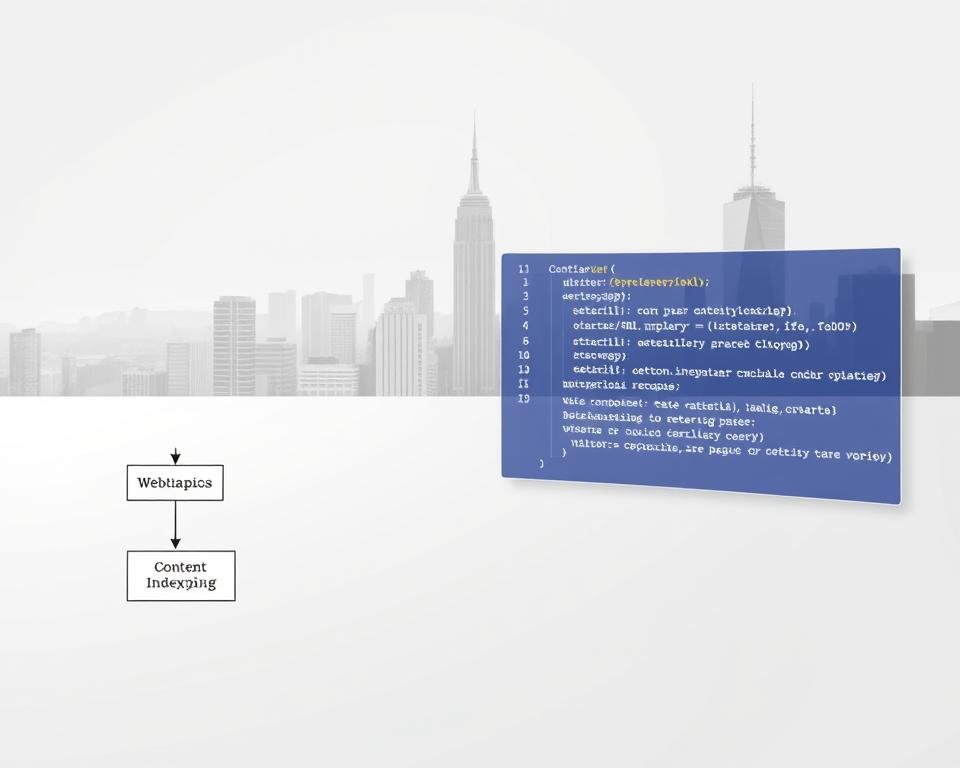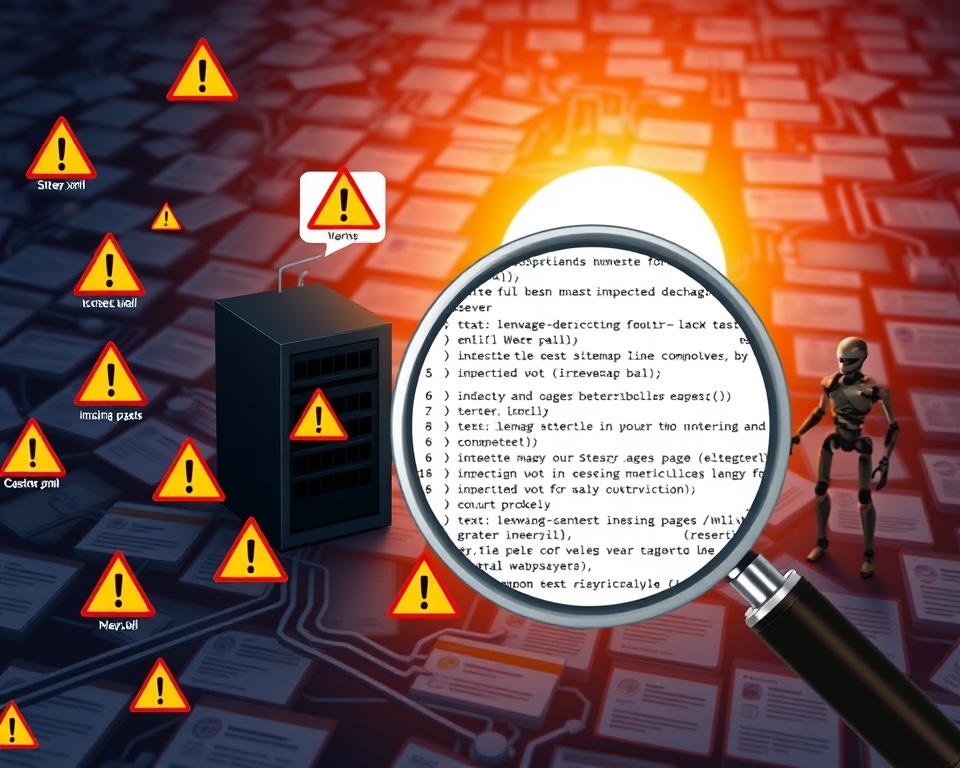Exploring search engine optimization (SEO), I see how vital Robots.txt and Sitemap.xml are. They help your website get seen more by search engines. This means more people can find your site.
Search engines use robotic technology and artificial intelligence to understand your site better. In this article, I’ll explain what these files are and why they matter for your website’s success.
Key Takeaways
- Understanding the importance of Robots.txt and Sitemap.xml for SEO optimization
- Improving crawl efficiency and crawl rates with these files
- Leveraging robotic technology and artificial intelligence for better content indexing
- Enhancing website visibility and driving more traffic
- Crucial role of these files in website success
Understanding Robots.txt and Sitemap.xml
Knowing how Robots.txt and Sitemap.xml work is key for good SEO. These files are important for how search engines see your website.
What is Robots.txt?
Robots.txt is a file for webmasters to tell search engine crawlers what to do. It’s part of the robots exclusion protocol (REP). This group of standards helps control how robots crawl and index websites.
It tells search engines which pages to crawl and which not to. This helps avoid duplicate content and saves server resources.
What is Sitemap.xml?
Sitemap.xml lists a website’s URLs to help search engines find and crawl pages. It’s like a map for search engines to understand your site’s layout and content.
A good Sitemap.xml helps index your website’s pages better. It’s great for big or complex sites. It also shares details like when pages were last updated.
Key Differences Between the Two
Robots.txt and Sitemap.xml have different jobs. Robots.txt tells search engines how to crawl your site. Sitemap.xml helps them find your site’s content.
- Robots.txt controls crawler behavior and keeps some pages from being indexed.
- Sitemap.xml helps search engines find and index your website’s pages.
Both files are key for a strong SEO plan. They help your website be more visible and easy to crawl. By using Robots.txt and Sitemap.xml well, you can boost your site’s ranking and online presence.
The Importance of Robots.txt
The Robots.txt file is key in how search engines see your website. It tells them which pages to check and which to skip. This affects how visible your site is and its SEO score.
Robots.txt helps manage search engine crawlers. It stops them from wasting time on the same page over and over. This is good for your site’s ranking.
Controlling Search Engine Crawlers
Robots.txt helps crawlers focus on the most important pages. This makes them work better and index the right content. For example, it keeps crawlers away from login pages or duplicate products.
Good crawler control means your site’s main pages get indexed better. This is key for sites that change a lot, like news or online shops. It makes sure the latest info is seen by search engines.

Preventing Duplicate Content Issues
Robots.txt also stops duplicate content problems. It keeps crawlers from seeing the same page twice. This stops search engines from thinking your site is spam.
For example, if your online store has many product pages with the same description, Robots.txt can help. It keeps crawlers from indexing these duplicates. This keeps your site’s content clean and helps your SEO.
In short, Robots.txt is essential for any website wanting better search engine results. It controls how search engines see your site and stops duplicate content problems. This boosts your site’s efficiency and visibility.
The Role of Sitemap.xml
Sitemap.xml is key for search engines to find and list my website’s pages. It gives a clear list of URLs. This helps search engines see my website’s structure and content, boosting its visibility.
A good Sitemap.xml does more than list URLs. It organizes them in a way that’s easy for both users and search engines. It also includes metadata and stays updated with my website’s changes.
Ensuring Indexation of Your Pages
Sitemap.xml’s main job is to make sure all my website’s pages are found by search engines. This is very important for new or changed content. It helps search engines find and crawl these pages faster.
To do this, I must make sure my Sitemap.xml has all the right URLs. I also need to send it to big search engines. This helps avoid problems with being listed and makes my content easy to find in search results.

Improving SEO Through Structured Data
Sitemap.xml also helps with SEO by adding structured data. By adding extra metadata, I give search engines more info about my content. This makes my website more relevant and trusted.
For example, if my site talks about robotic innovations or robot design, a good Sitemap.xml helps search engines see that. This makes it easier for them to rank my content right.
Using Sitemap.xml well can really boost my website’s SEO. This brings more focused visitors and improves my site’s online presence.
How Robots.txt Works
Learning about Robots.txt is vital for search engines to find and show your website. It helps your site be seen more and keeps it safe from bad crawling.
Syntax and Formatting Guidelines
The Robots.txt rules are simple but need careful attention. Here’s how to do it right:
- Use “User-agent:” to tell which crawler to apply the rule to.
- Use “Disallow:” to say which pages or directories to skip.
- Use “Allow:” to let specific pages or directories be crawled, even if “Disallow:” says no.
Remember, the file is sensitive to capital letters. Also, don’t use wildcard characters unless you really need to.
Common Commands Used
There are a few key commands in Robots.txt to tell crawlers what to do. Here are some:
- User-agent: * – Tells all crawlers to follow the next rules.
- Disallow: /private/ – Stops crawlers from getting into the “/private/” area.
- Allow: /private/public/ – Lets crawlers into the “/private/public/” area, even if “Disallow:” says no.
- Crawl-delay: 10 – Tells crawlers to wait 10 seconds before making another request.
Using these commands wisely helps control how search engines see your site. This makes crawling better and keeps your site safe from too much traffic.

As artificial intelligence grows, Robots.txt’s role in guiding AI crawlers will get bigger. Keeping up with Robots.txt best practices helps your site work well with search engines and AI.
How Sitemap.xml Functions
A well-structured Sitemap.xml is key for search engines to navigate your website. It acts as a roadmap, showing the site’s layout and new pages.

URL Structure and Formatting
The URL structure in your Sitemap.xml is vital for search engines to crawl and index your site. It’s important to include relevant URLs and skip unimportant or duplicate ones. Use the right protocol (http or https) and keep URLs simple.
Here are some tips for your Sitemap.xml’s URL structure:
- Use absolute URLs instead of relative ones.
- Steer clear of URLs with extra parameters.
- Make sure your URLs can be crawled and aren’t blocked by Robots.txt.
Including Metadata in Your Sitemap
Adding metadata to your Sitemap.xml boosts its usefulness. It gives search engines more context about your URLs. This includes the last update date, how often it changes, and its priority.
Metadata helps search engines see how often your content is updated. It’s great for sites with lots of changes or many pages.
For example, the lastmod tag tells search engines when a URL was last updated. This can help them focus on newer or updated content.
Implementing Robots.txt for Your Website
Setting up a Robots.txt file is important. It helps search engines know which pages to visit and which to skip. A good Robots.txt file makes your website more visible online.
Best Practices for Setting Up
When you create your Robots.txt file, follow some key steps. First, learn the right way to write it to avoid mistakes. Be careful with the commands you use. Wrong ones can hide important pages from search engines.
Here’s how to set up your Robots.txt file right:
- Specify the user-agent to which the directives apply.
- Use the “Disallow” directive to block access to specific pages or directories.
- Utilize the “Allow” directive to grant access to specific pages or directories within a disallowed directory.
- Consider using the “Crawl-delay” directive to control the crawl rate.

Tips for Testing Your Robots.txt File
After setting up your Robots.txt file, test it to make sure it works. Use tools like Google Search Console to check for problems. It’s also smart to update your Robots.txt file when your website changes.
Here are some tips for testing your Robots.txt file:
- Check if your Robots.txt file is formatted right and has no errors.
- Test your Robots.txt file with Google Search Console or other SEO tools.
- Watch your website’s crawl rate and tweak your Robots.txt file if needed.
By following these tips and testing your Robots.txt file, you make your website better for search engines. This can help your website show up more in search results. It’s like how robotics engineering and robotics applications are making industries better.
Creating an Effective Sitemap.xml
A sitemap.xml is like a map for search engines to find your website. It helps them understand your site’s layout. This makes your site easier to find.
To make a good sitemap.xml, you need to pick the right tools. You also have to submit it to search engines.
Tools for Generating a Sitemap
Many tools can help you make a sitemap.xml. You can find online generators or plugins for CMS like WordPress.
- Online Sitemap Generators: Tools like Sitemap Generator and XML Sitemap Generator can create a sitemap.xml for your website quickly.
- CMS Plugins: If you’re using a CMS like WordPress, plugins such as Yoast SEO and Google XML Sitemaps can automatically generate and update your sitemap.xml.
- Custom Scripts: For more advanced users, custom scripts can be developed to generate a sitemap.xml based on specific requirements.
Submitting Your Sitemap to Search Engines
After making your sitemap.xml, you need to send it to search engines like Google and Bing.
- Google Search Console: You can submit your sitemap.xml through Google Search Console, which helps Google understand your website’s structure and index it more efficiently.
- Bing Webmaster Tools: You can also send your sitemap.xml to Bing using Bing Webmaster Tools.
Using the right tools to make your sitemap.xml and sending it to search engines boosts your site’s visibility. It also helps search engines crawl your site better.

| Tool | Description | Use Case |
|---|---|---|
| Online Sitemap Generators | Web-based tools that generate sitemap.xml | Ideal for small to medium-sized websites |
| CMS Plugins | Plugins for CMS like WordPress that automatically generate sitemap.xml | Suitable for websites managed through CMS platforms |
| Custom Scripts | Custom-developed scripts for generating sitemap.xml | Best for large or complex websites with specific needs |
Common Mistakes to Avoid in Robots.txt
Optimizing your website for search engines is key. A well-made Robots.txt file helps search engines know which pages to visit and which to skip. This is important for your SEO.
But, mistakes in your Robots.txt file can hurt your SEO. I’ll show you how to avoid these mistakes. This way, your website will stay optimized for search engines.
Overblocking Important Pages
One big mistake is blocking too many important pages. This happens when search engines can’t find key parts of your site. It can hide your content from search results.
- Avoid using broad rules that might block important pages.
- Check your Robots.txt file often to make sure it’s not blocking important files like CSS or JavaScript.
- Use tools like Google Search Console to test your Robots.txt file. This helps find problems before they get big.
By watching out for these mistakes, your Robots.txt file will help your SEO, not hurt it. Artificial intelligence in SEO tools can also help fix these issues quickly.
Ignoring the Crawl Delay Directive
Another mistake is ignoring the crawl delay directive. This tells search engines how often to visit your site. It helps prevent your site from getting too busy and slowing down.
- Find the right crawl delay for your site’s server and how often it changes.
- Put the crawl delay directive in your Robots.txt file. This makes sure you’re not slowing down or speeding up search engines too much.
- Keep an eye on your site’s performance. Adjust the crawl delay as needed to keep a good balance.
By avoiding these mistakes and using automation tools, you can make your Robots.txt file work well with search engines. This will help your website be more visible and improve your SEO.
Common Pitfalls in Sitemap.xml
A well-structured Sitemap.xml is key for SEO. But, many pitfalls can harm its effectiveness. It’s vital to keep your Sitemap.xml up-to-date and accurate.
In the robotics world, where tech advances fast, a stale Sitemap.xml can cause big problems. New content, like articles on robotics or machine learning, might not get indexed quickly.
Neglecting to Update Regularly
One big mistake is not updating the Sitemap.xml often. This can stop search engines from finding new or updated pages. For example, if a robotics site posts new content often, not updating the Sitemap.xml can delay search engines from seeing it.
To fix this, automate Sitemap.xml updates for new or changed content. This helps search engines find and index your site’s pages well.
Failing to Include Important URLs
Another mistake is leaving out key URLs in the Sitemap.xml. This can make search engines miss important pages. For instance, if a site has tutorials or guides on machine learning, not including them in the Sitemap.xml means they won’t be indexed.
To avoid this, check the Sitemap.xml often. Make sure all important URLs are there. This means looking at your site’s key pages and making sure they’re in the Sitemap.xml.

| Best Practice | Common Pitfall |
|---|---|
| Regularly updating Sitemap.xml | Neglecting to update Sitemap.xml, leading to indexing delays |
| Including all important URLs | Failing to include critical pages, resulting in reduced visibility |
| Automating Sitemap.xml updates | Manual updates leading to human error |
By avoiding these mistakes and following best practices, you can make your Sitemap.xml work better. This helps search engines crawl and index your site better, boosting your SEO.
The Benefits of Using Both Files
Robots.txt and Sitemap.xml work together to make your website better. They help search engines find and show your site more. This makes your website more visible and improves its SEO.
Using both files helps search engines crawl your site better. This means they can find and index your pages more efficiently.
Enhancing Crawl Efficiency
Robots.txt controls how search engines crawl your site. It stops them from seeing certain pages or areas. Sitemap.xml, on the other hand, shows search engines where to find your content.
Key benefits of enhanced crawl efficiency include:
- Faster indexing of new content
- Reduced crawl errors
- Improved overall website visibility
Boosting Your Website’s Crawl Rate
Optimizing Robots.txt and keeping Sitemap.xml up-to-date boosts your crawl rate. This means search engines visit and index your site more often. Your content stays fresh and relevant in search results.
To maximize the benefits, ensure that:
- You regularly update your Sitemap.xml to reflect changes in your website’s content.
- You use Robots.txt to guide crawlers towards your most important pages.
By using both files well, you can improve your website’s SEO. This drives more traffic and boosts your search engine rankings.
Monitoring the Impact of Robots.txt and Sitemap.xml
To see how well your Robots.txt and Sitemap.xml work, you need to watch their effect on your site. Look at how your website traffic changes. Use tools like Google Search Console to learn more.
Analyzing Website Traffic Changes
Changes in website traffic show if your Robots.txt and Sitemap.xml are doing their job. A drop in traffic might mean Robots.txt is blocking important pages. But, an increase could mean your Sitemap.xml is helping search engines find your best content.
To check traffic changes, use Google Analytics. Compare your traffic before and after updating your Robots.txt or Sitemap.xml. This will show you their impact.
| Metric | Before Changes | After Changes |
|---|---|---|
| Organic Traffic | 1000 | 1200 |
| Bounce Rate | 50% | 45% |
| Average Session Duration | 2 minutes | 2.5 minutes |
Using Google Search Console for Insights
Google Search Console is a great tool for seeing how Google views your site. It shows how your site is crawled, indexed, and searched.
By linking your site to Google Search Console, you can:
- Watch for crawl errors and learn how to fix them.
- See which pages are indexed and which aren’t.
- Find out how people find your site through search.
With these insights, you can make your Robots.txt and Sitemap.xml better. For example, if some pages aren’t indexed, add them to your Sitemap.xml.
Future Trends in Robots.txt and Sitemap.xml
New technologies, like artificial intelligence, will change how we use Robots.txt and Sitemap.xml. It’s important to keep up with these changes to stay ahead in search rankings.
Evolving SEO Practices
SEO is always changing, and so are Robots.txt and Sitemap.xml. Search engines are getting smarter, so we need to adjust how we optimize these files. Here are some trends to watch:
- Increased Use of AI: Artificial intelligence will be more important for search engines to crawl and index websites.
- More Complex Crawling Rules: Websites are getting more complex, so crawling rules will need to get more detailed.
- Greater Emphasis on User Experience: SEO will focus more on how users feel, and Robots.txt and Sitemap.xml will need to reflect this.
The Role of AI in Web Crawling and Indexing
Artificial intelligence is changing how search engines work. AI can analyze lots of data quickly, making search results better. This change affects how we handle Robots.txt and Sitemap.xml.
AI could bring many benefits, like:
- Improved Crawl Efficiency: AI can make search engines crawl websites faster, which is good for servers and indexing.
- Better Indexing of Complex Content: AI can help index complex content, like dynamic web pages and videos.
- Enhanced Security: AI can spot and stop security threats, like bad bots and spam.
As AI gets better, we’ll need to optimize Robots.txt and Sitemap.xml to work with it. By keeping up with these trends, website managers can keep their sites visible and competitive online.
Conclusion: The Necessity of Robots.txt and Sitemap.xml
Optimizing a website is like robotics engineering. It needs details like Robots.txt and Sitemap.xml. These are key for search engine optimization (SEO).
Key Takeaways
Robots.txt and Sitemap.xml help control search engine crawlers. They make sure web pages are indexed. By using these files right, websites can get more seen and crawled.
Best Practices for the Future
Robot technology is getting better, so website management must too. Keeping up with SEO trends is important. Using Robots.txt and Sitemap.xml helps websites get more visitors and succeed over time.
